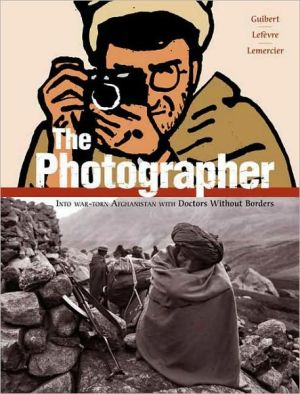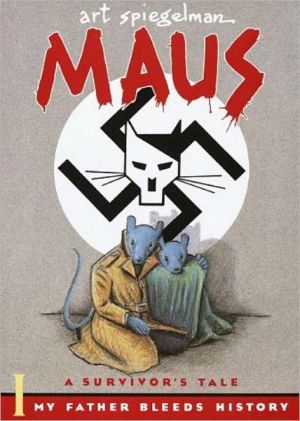The Photographer: Into War-Torn Afghanistan with Doctors Without Borders
In 1986, Afghanistan was torn apart by a war with the Soviet Union. This graphic novel/photo-journal is a record of one reporter’s arduous and dangerous journey through Afghanistan, accompanying the Doctors Without Borders. Didier Lefevre’s photography, paired with the art of Emmanuel Guibert, tells the powerful story of a mission undertaken by men and women dedicated to mending the wounds of war.\ \ \ Winner of the 2010 Eisner Award for Best U.S. Edition of...
Search in google:
In 1986, Afghanistan was torn apart by a war with the Soviet Union. This graphic novel/photo-journal is a record of one reporter’s arduous and dangerous journey through Afghanistan, accompanying the Doctors Without Borders. Didier Lefevre’s photography, paired with the art of Emmanuel Guibert, tells the powerful story of a mission undertaken by men and women dedicated to mending the wounds of war.The New York Times - Chris HedgesIt is impossible to know war if you do not stand with the mass of the powerless caught in its maw. All narratives of war told through the lens of the combatants carry with them the seduction of violence. But once you cross to the other side, to stand in fear with the helpless and the weak, you confront the moral depravity of industrial slaughter and the scourge that is war itself. Few books achieve this clarity. The Photographer is one. A strange book, part photojournalism and part graphic memoir, The Photographer tells the story of a small mission of mostly French doctors and nurses who traveled into northern Afghanistan by horse and donkey train in 1986, at the height of the Soviet occupation. The book shows the damage done to bodies and souls by shells, bullets and iron fragments, and the frantic struggle to mend the broken.
\ From the Publisher"An unflinching and gripping photographic memoir, the Photographer takes you on a breathtaking journey through the best and worst humanity has to offer in times of war. Turning its pages, the reader begins to understand what it means to lose everything as a refugee of war, to cross mountains to help someone you never met, to feel the intense responsibility of being the only one able to capture the last moments of a child's stolen life. Suddenly Afghanistan, a distant land, a foreign culture, a courageous and resilient people seem closer, more familiar--more human. I love this book."\ --Angelina Jolie, UNHCR Goodwill Ambassador\ “The Photographer is a work of stunning originality and power. It seamlessly blends personal storytelling, photography, and illustration to reveal the essential work of Doctors Without Borders. It is to Didier Lefevre’s immense credit that he risked his life to bring that story to light. This amazing work gives us a window into the suffering and perseverance of the Afghan people. Above all else, it is a truly inspiring piece of work.” -- Sebastian Junger, author of The Perfect Storm\ “One of the most amazing publications I’ve ever read.” -- Rachel Maddow, MSNBC\ “There is no fighting in this book. No great warriors are exalted. The story is about those who live on the fringes of war and care for its human detritus. By the end of the book the image or picture of a weapon is distasteful. And if you can achieve this, you have gone a long way to imparting the truth about warfare.” – The New York Times Book Review\ “An inspiring book about a perpetually knotty country at the height of the Soviet-Afghan conflict, The Photographer should be mandatory reading for our Secretary of State and President.” – The Boston Globe\ “A sweeping declaration of human strength, compassion and creative power.” – The LA Times\ “Haunting . . . a riveting account.” – The Washington Post\ "Reading The Photographer is a simply stunning experience: you emerge from your time spent in Pakistan and Afghanistan with Didier and the members of MSF a better, more thoughtful person." -- Nancy Pearl, NPR\ “A gripping adventure that sheds light on subjects as diverse as faith, photography, art, love, nobility, Soviet-Afghani relations, pride, masculinity, racism, and bravery. This isn’t just a great photography book, it’s a great novel, a great comic, a great memoir, and a great history text.” -- boingboing\ “The Photographer is an absorbing graphic memoir . . . Lefevre’s work is stunning, capturing not just the beauty of the terrain, but the stories etched onto the faces of the Afghan people.” – The Cleveland Plain Dealer\ “The Photographer will make you weep, laugh and empty your pockets to donate to the extraordinarily courageous Doctors Without Borders.” – The Hartford Advocate\ “The Photographer marries the amazing pictures of Didier Lefevre with the images and text of Emmanuel Guibert. The result is a blazingly honest, riveting memoir that stands as one of the best examples of graphic literature.” – The Graphic Novel Reporter\ “A staggering graphic achievement . . . The Photographer is a huge, huge success, graphically, narratively, humanistically.” -- Newsarama\ “A haunting and at times harrowing tale that highlights the cost of war on the people of Afghanistan while illuminating the humanitarian mission of the volunteers that work with Doctors Without Borders.” – Publisher’s Weekly Comics Week\ “A compelling, one-of-a-kind reading experience . . . bringing you the real-world adventure of a young photographer risking his life with one of the bravest, most beloved humanitarian organizations in the world.” – Shelf Awareness\ “An incredibly honest portrayal of common figures in the middle of incredible situations.” – Inkstuds\ “Stunning and unique.” – Playback: stl\ “Perhaps no medium other than this one’s could convey so tangibly what it is to deliver ‘human services’ in a war zone in one of the least geographically hospitable, most beautiful places on earth. A magnificent achievement.” – Booklist, starred review\ “An expansive narrative that ranges from a discerning glimpse of a very different and variegated culture to an at times heartbreaking chronicle of the horrors of modern warfare to a desperate struggle for survival. . . . an unforgettable reading experience.” ICv2\ “[A] magnificent and moving account of the human costs of war.” – Library Journal, starred review\ “Starkly beautiful . . . magnificent.” – Publisher’s Weekly, starred review\ “Horrifying and glorious. . . . a part of the world that should be discussed more often.” – VOYA\ \ \ \ \ \ Douglas WolkThe Photographer is a riveting account of Lefevre's first journey and his experiences in Zaragandara, the Afghan town where Doctors Without Borders set up a makeshift hospital. Lefevre's blisteringly forceful black-and-white photographs, and sometimes his contact sheets, appear on nearly every page of the book. So does Emmanuel Guibert's artwork. The cartoonist adapted his friend's memories of the trip into comics form, filling in the spaces between photos with sequences that bind the story together (and providing, understandably, almost every image we see of Lefevre himself) and explain what was happening at less photogenic moments.\ —The Washington Post\ \ \ Chris HedgesIt is impossible to know war if you do not stand with the mass of the powerless caught in its maw. All narratives of war told through the lens of the combatants carry with them the seduction of violence. But once you cross to the other side, to stand in fear with the helpless and the weak, you confront the moral depravity of industrial slaughter and the scourge that is war itself. Few books achieve this clarity. The Photographer is one. A strange book, part photojournalism and part graphic memoir, The Photographer tells the story of a small mission of mostly French doctors and nurses who traveled into northern Afghanistan by horse and donkey train in 1986, at the height of the Soviet occupation. The book shows the damage done to bodies and souls by shells, bullets and iron fragments, and the frantic struggle to mend the broken.\ —The New York Times\ \ \ \ \ Publishers WeeklyThis documentary graphic novel brings together starkly beautiful black and white photographs taken by Lefèvre, intimate drawings by Guibert, skillful design by Lemercier and a vibrant translation and thorough introduction by Siegel. In 1986, photographer Lefèvre was hired by Médecins sans Frontières (MSF; Doctors Without Borders), to document a mission into northern Afghanistan. Along the way, he and the doctors, guides and interpreters with whom he traveled endured physical hardship and the fracas of war. In one memorable scene, the group must cross an open plateau where Russian planes fired on the previous MSF caravan. Photographs acting as panels emphasize the vast openness of the plateau, while drawings allow a glimpse of the small human gestures of the travelers. Arriving on the other side of the plateau, they reach a wooded area "where, two years ago, they buried the man who didn't make it." This revelation is punctuated by a large photograph of the burial mound under the trees, the mix of drawings and photographs heightening the emotional impact. Originally published in three volumes in France, the book has sold more than 250,000 copies there, and the reach of this magnificent work promises to extend far beyond the graphic novel community. (May)\ Copyright © Reed Business Information, a division of Reed Elsevier Inc. All rights reserved.\ \ \ \ \ VOYAOriginally published as three volumes in France from 2003 to 2006, this graphic novel follows photojournalist Didier Lefevre during his three months in Pakistan and Afghanistan in 1986 as he documented the medical missions of Doctors without Borders. Unable to travel by road because the Soviet army monitored them, they journeyed through the mountain passes in caravans of horses and donkeys. The villages where they stopped along the way showcased the horrors of a war-torn country, the damage done to both the people and the countryside, and how humanity still survives. His solo journey back to Pakistan is wrought with hardship including abandonment by his escorts, freezing temperatures, the death of his horse, illness, and being taken advantage of by both escorts and police. The chronicle of Lefevre's learning experience creates a similar effect on the reader. The graphic novel combines traditional comic art with some of the four thousand photographs Lefevre shot while in Afghanistan. The comic artwork by Guibert is primarily small square panels with realistic figures. The powerful photographs are where the real story unfolds. Many images will stay with readers as both horrifying and glorious. The Afghan children being treated for burns, bullet wounds, and shrapnel are page by page next to the beauty of the Afghan mountainous landscapes. Although this nonfiction graphic novel will not be very popular with the common reader, it has a powerful message and images of a part of the world that should be discussed more often. Reviewer: Kristin Fletcher-Spear\ \ \ \ \ Library JournalBy truck, it would have taken a day or two, but the government army and the Russians were holding the roads. So instead it was a three-week march with pack animals over the mountains, like Marco Polo. LefA vre was photojournalist to a 1986 Doctors Without Borders team, off to staff M*A*S*H-style clinics in northeast Afghanistan. Fantasy doesn't get any stranger than trekking overland, techno-free, into a completely different culture. LefA vre's photos tell his story of the wonderful, intriguing Afghani people and their sweeping country, while Guibert's drawings tell the story of LefA vre telling his story. As a result, Afghani life seems more real than LefA vre's-and somehow that seems right. This magnificent and moving account of the human costs of war won the Canadian BA©dA©lys Prize and sold hundreds of thousands of copies in Europe. The heroism of the doctors contrasts with the daily hassles of surviving in Afghanistan and with LefA vre's loneliness, exhaustion, misunderstanding, and several rash decisions that nearly cost him his life. This has the potential to attract noncomics readers and inspire another generation of humanitarian heroes; highly recommended for high school and up. Needs topic-specific cataloging.\ —Martha Cornog\ \ \ \ \ \ School Library JournalGr 10 Up—Lefèvre was a photographer who attached himself to a 1986 Doctors Without Borders (MSF) expedition into Afghanistan during its war with the USSR. Almost 20 years later, he worked with artist Guibert to create this stunning narrative of that trip. Lefèvre shot well over 100 rolls of film in Pakistan and Afghanistan as he crossed the border in a donkey convoy, watched the medical staff diagnose and treat young and old wounded in the war or sickened by disease, and headed back into Pakistan escorted only by a variety of guides, not all of whom had his interests uppermost in their minds. Guibert worked with Lefèvre to create the story that links these photographic images, most of which are black and white, with panels beautifully colored by Lemercier. The latter describe relationships among the travelers and with the local people, Lefèvre's political awakening, and assorted physical and emotional hazards, especially on his return trip without an MSF escort. This tour de force is essential reading for students interested in international relations, journalism, memoir, and the practice of medicine in Third World circumstances. Lefèvre's initial lack of political sophistication will resonate with thoughtful teens.—Francisca Goldsmith, Halifax Public Libraries, Nova Scotia\ \








